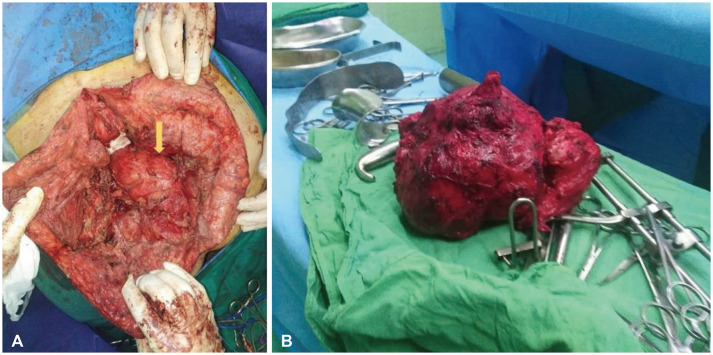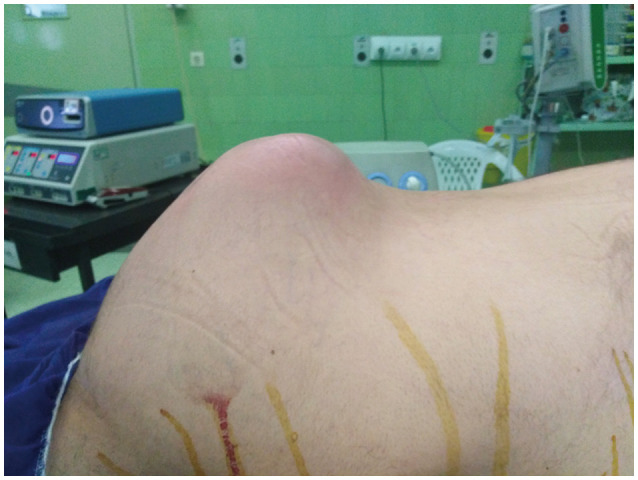1. Varga PP, Lazary A. Chordoma of the sacrum: “en bloc” high partial sacrectomy. Eur Spine J. 2010; 19:1037–1038. PMID:
20514500.

2. Hanna SA, Aston WJ, Briggs TW, Cannon SR, Saifuddin A. Sacral chordoma: can local recurrence after sacrectomy be predicted? Clin Orthop Relat Res. 2008; 466:2217–2223. PMID:
18584264.

3. Baratti D, Gronchi A, Pennacchioli E, Lozza L, Colecchia M, Fiore M, et al. Chordoma: natural history and results in 28 patients treated at a single institution. Ann Surg Oncol. 2003; 10:291–296. PMID:
12679315.

4. Farsad K, Kattapuram SV, Sacknoff R, Ono J, Nielsen GP. Sacral chordoma. Radiographics. 2009; 29:1525–1530. PMID:
19755609.

5. Jemal A, Siegel R, Ward E, Murray T, Xu J, Thun MJ. Cancer statistics, 2007. CA Cancer J Clin. 2007; 57:43–66. PMID:
17237035.
6. Chugh R, Tawbi H, Lucas DR, Biermann JS, Schuetze SM, Baker LH. Chordoma: the nonsarcoma primary bone tumor. Oncologist. 2007; 12:1344–1350. PMID:
18055855.
7. Lauer SR, Edgar MA, Gardner JM, Sebastian A, Weiss SW. Soft tissue chordomas: a clinicopathologic analysis of 11 cases. Am J Surg Pathol. 2013; 37:719–726. PMID:
23588366.
8. Tirabosco R, Mangham DC, Rosenberg AE, Vujovic S, Bousdras K, Pizzolitto S, et al. Brachyury expression in extra-axial skeletal and soft tissue chordomas: a marker that distinguishes chordoma from mixed tumor/myoepithelioma/parachordoma in soft tissue. Am J Surg Pathol. 2008; 32:572–580. PMID:
18301055.
9. Rekhi B. Primary, large extra-axial chordoma in proximal tibia: a rare case report with literature review and diagnostic implications. APMIS. 2016; 124:238–242. PMID:
26522887.
10. Walcott BP, Nahed BV, Mohyeldin A, Coumans JV, Kahle KT, Ferreira MJ. Chordoma: current concepts, management, and future directions. Lancet Oncol. 2012; 13:e69–e76. PMID:
22300861.
11. Housari G, González M, Calero P, Beni R, Lobo E. Sacral chordoma: management of a rare disease in a tertiary hospital. Clin Transl Oncol. 2013; 15:327–330. PMID:
22865326.
12. Atalar H, Selek H, Yildiz Y, Sağlik Y. Management of sacrococcygeal chordomas. Int Orthop. 2006; 30:514–518. PMID:
16552577.
13. Sung MS, Lee GK, Kang HS, Kwon ST, Park JG, Suh JS, et al. Sacrococcygeal chordoma: MR imaging in 30 patients. Skeletal Radiol. 2005; 34:87–94. PMID:
15480648.
14. Rao BSS, Menezes LT, Rao AD, John SK. Sacral chordoma-a report oftwo cases. Indian J Surg. 2005; 67:207–209.
15. Park L, Delaney TF, Liebsch NJ, Hornicek FJ, Goldberg S, Mankin H, et al. Sacral chordomas: impact of high-dose proton/photon-beam radiation therapy combined with or without surgery for primary versus recurrent tumor. Int J Radiat Oncol Biol Phys. 2006; 65:1514–1521. PMID:
16757128.
16. McMaster ML, Goldstein AM, Bromley CM, Ishibe N, Parry DM. Chordoma: incidence and survival patterns in the United States, 1973-1995. Cancer Causes Control. 2001; 12:1–11. PMID:
11227920.
17. Akiyama T, Yamamoto A, Kashima T, Ishida T, Shinoda Y, Goto T, et al. Juxtacortical chondroma of the sacrum. J Orthop Sci. 2008; 13:476–480. PMID:
18843465.
18. Fourney DR, Gokaslan ZL. Current management of sacral chordoma. Neurosurg Focus. 2003; 15:E9.
19. Bergh P, Kindblom LG, Gunterberg B, Remotti F, Ryd W, Meis-Kindblom JM. Prognostic factors in chordoma of the sacrum and mobile spine: a study of 39 patients. Cancer. 2000; 88:2122–2134. PMID:
10813725.

20. Ferraresi V, Nuzzo C, Zoccali C, Marandino F, Vidiri A, Salducca N, et al. Chordoma: clinical characteristics, management and prognosis of a case series of 25 patients. BMC Cancer. 2010; 10:22. PMID:
20109225.
21. Cho HY, Lee M, Takei H, Dancer J, Ro JY, Zhai QJ. Immunohistochemical comparison of chordoma with chondrosarcoma, myxopapillary ependymoma, and chordoid meningioma. Appl Immunohistochem Mol Morphol. 2009; 17:131–138. PMID:
19521276.

22. Kayani B, Sewell MD, Hanna SA, Saifuddin A, Aston W, Pollock R, et al. Prognostic factors in the operative management of dedifferentiated sacral chordomas. Neurosurgery. 2014; 75:269–275. PMID:
24867206.
23. Ishii K, Chiba K, Watanabe M, Yabe H, Fujimura Y, Toyama Y. Local recurrence after S2-3 sacrectomy in sacral chordoma. Report of four cases. J Neurosurg. 2002; 97:98–101. PMID:
12120660.
24. Pillai S, Govender S. Sacral chordoma: a review of literature. J Orthop. 2018; 15:679–684. PMID:
29881220.
25. Chandawarkar RY. Sacrococcygeal chordoma: review of 50 consecutive patients. World J Surg. 1996; 20:717–719. PMID:
8662159.
26. Kishimoto R, Omatsu T, Hasegawa A, Imai R, Kandatsu S, Kamada T. Imaging characteristics of metastatic chordoma. Jpn J Radiol. 2012; 30:509–516. PMID:
22592289.
27. Gerber S, Ollivier L, Leclère J, Vanel D, Missenard G, Brisse H, et al. Imaging of sacral tumours. Skeletal Radiol. 2008; 37:277–289. PMID:
18034341.
28. Asavamongkolkul A, Waikakul S. Wide resection of sacral chordoma via a posterior approach. Int Orthop. 2012; 36:607–612. PMID:
22038441.
29. Clarke MJ, Dasenbrock H, Bydon A, Sciubba DM, McGirt MJ, Hsieh PC, et al. Posterior-only approach for en bloc sacrectomy: clinical outcomes in 36 consecutive patients. Neurosurgery. 2012; 71:357–364. PMID:
22569060.
30. Ozger H, Eralp L, Sungur M, Atalar AC. Surgical management of sacral chordoma. Acta Orthop Belg. 2010; 76:243–253. PMID:
20503952.








 PDF
PDF Citation
Citation Print
Print





 XML Download
XML Download